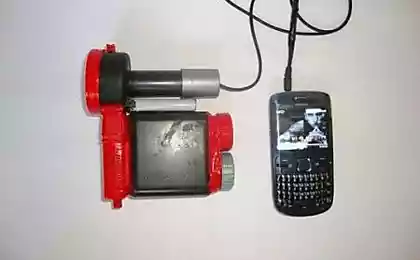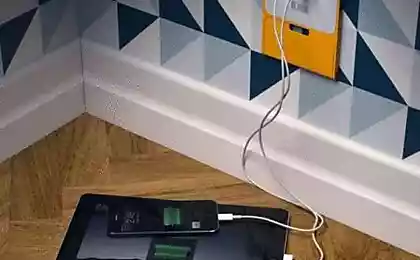575
Do I need to remove from the socket of the charger when not in use?
You may have already heard about the so-called "energy vampires" — appliances that continue to consume small amount of energy even when they are in standby mode. The question is, how much of this energy consume battery charger, and should we worry about disconnecting them from the network while not to use them?
How to check at home
To measure the energy consumption of any charger we were using household power meter Kill-A-Watt. Acquiring a similar power meter and the average meter costs about 24 dollars, you will be able to determine the level of energy consumption in the home. To do this, insert the meter into the outlet, then connect the device, and the device will show you the demanded amount of energy. Especially makes sense to do it when you need to replace or adjust energy-consuming appliances and devices. If you are aware of the electricity tariff in your region, you will be easy to calculate your costs.
So, with the meter in one hand and a pile of chargers in the other, we will test for you.

Whether the charger "energy vampires"?
Connecting to the network all of our chargers from Nintendo 3DS, smartphones and tablets, iPhone and IPAD, Chromebook, MacBook and laptops with Windows OS – we realized that from the very beginning has gone astray. Being fairly aware of the need to unplug "energy vampires sleeping", we were very surprised to find out that no charger is not spent even the smallest amount of energy that our measuring device would be able to fix.
In other words, the display wattmeter still showed 0.0 watts, no matter what kind of charger we're hooked.
And yet, they consume energy
Will be incorrect to say that the chargers do not use electricity, just its consumption does not exceed a few fractions of a watt. At some point, it is definitely possible to detect.
And then we had a new idea — connect to the power meter extension cord, and extension cords — different chargers. We'll see how much the chargers to move the testimony of our power meter off the ground.
Despite the burning on our extension cord red led power meter consistently showed 0.0 watts in the beginning of the experiment and even when we added a few chargers.
The first value on the measuring instrument appeared, finally, when the extension cable was connected for six chargers and all his sockets were filled. The total amount of energy consumed at the same time chargers, iPhone 6, iPad Air, MacBook Air, Surface pro 2, Samsung Chromebook and the Nexus 7 was 0.3 watts.
So how much is it worth?
In the end, we got the meter, suitable for further use: 0.3 W.
For example, all the chargers are connected to the network 24 hours a day, seven days a week for the whole year, i.e. 8760 hours per year. Thus, it is 2.628 kWh.
In the United States the average cost of one kilowatt-hour is 12.98 cents, which means 2.628 kWh will cost approximately 34.1 per cent per year. But even in Hawaii, where applies the highest tariff for electricity in the United States, that is, 30.04 cents per one kilowatt-hour, the cost will not exceed 79 cents a year.
Thus, the real value will even be lower, as from time to time you will use the charger for its intended purpose and not in standby mode, so they will not always be "energy vampires." Also you will probably turn them off to take to the road.
But let's analyze the biggest of calculated values was 79 cents a year. Dividing it into six chargers (let's agree not to pay attention to the extension), you will receive about 13 cents a year for each charger in Hawaii or about five and a half cents on average for other American region.
The main conclusion obtained in spite of the approximation calculations
This, of course, not completely accurate scientific experiment. Some chargers use more energy than others, so the ability to remove the charger from your smartphone from the outlet throughout the year can cost you less thirteen cents.
In any case, the result shows that the amount of power consumed by the chargers, is so inconsequential that there is no point to worry. Simply leave your charger plugged in, if you prefer, do not remove them from the socket.
Of course, you could save a little electricity by disabling your charger, but you will save even more if you become more attentive to follow the other, much more expensive sources of energy consumption like heating, lighting, air conditioning, washing machine, computer, etc. Forget about the chargers!
Of course, for our experiment we took only a relatively modern device, the oldest of which is five years old. Older chargers can consume much more electricity. For example, if you're still using a cell phone or other handheld device manufactured in 90-ies, it is left plugged in, it may well turn into "energy vampires", but even in this case, your costs will not be able to break a significant dent in your budget.published
P. S. And remember, only by changing their consumption — together we change the world! © Join us at Facebook , Vkontakte, Odnoklassniki
Source: gearmix.ru/archives/23481
How to check at home
To measure the energy consumption of any charger we were using household power meter Kill-A-Watt. Acquiring a similar power meter and the average meter costs about 24 dollars, you will be able to determine the level of energy consumption in the home. To do this, insert the meter into the outlet, then connect the device, and the device will show you the demanded amount of energy. Especially makes sense to do it when you need to replace or adjust energy-consuming appliances and devices. If you are aware of the electricity tariff in your region, you will be easy to calculate your costs.
So, with the meter in one hand and a pile of chargers in the other, we will test for you.

Whether the charger "energy vampires"?
Connecting to the network all of our chargers from Nintendo 3DS, smartphones and tablets, iPhone and IPAD, Chromebook, MacBook and laptops with Windows OS – we realized that from the very beginning has gone astray. Being fairly aware of the need to unplug "energy vampires sleeping", we were very surprised to find out that no charger is not spent even the smallest amount of energy that our measuring device would be able to fix.
In other words, the display wattmeter still showed 0.0 watts, no matter what kind of charger we're hooked.
And yet, they consume energy
Will be incorrect to say that the chargers do not use electricity, just its consumption does not exceed a few fractions of a watt. At some point, it is definitely possible to detect.
And then we had a new idea — connect to the power meter extension cord, and extension cords — different chargers. We'll see how much the chargers to move the testimony of our power meter off the ground.
Despite the burning on our extension cord red led power meter consistently showed 0.0 watts in the beginning of the experiment and even when we added a few chargers.
The first value on the measuring instrument appeared, finally, when the extension cable was connected for six chargers and all his sockets were filled. The total amount of energy consumed at the same time chargers, iPhone 6, iPad Air, MacBook Air, Surface pro 2, Samsung Chromebook and the Nexus 7 was 0.3 watts.
So how much is it worth?
In the end, we got the meter, suitable for further use: 0.3 W.
For example, all the chargers are connected to the network 24 hours a day, seven days a week for the whole year, i.e. 8760 hours per year. Thus, it is 2.628 kWh.
In the United States the average cost of one kilowatt-hour is 12.98 cents, which means 2.628 kWh will cost approximately 34.1 per cent per year. But even in Hawaii, where applies the highest tariff for electricity in the United States, that is, 30.04 cents per one kilowatt-hour, the cost will not exceed 79 cents a year.
Thus, the real value will even be lower, as from time to time you will use the charger for its intended purpose and not in standby mode, so they will not always be "energy vampires." Also you will probably turn them off to take to the road.
But let's analyze the biggest of calculated values was 79 cents a year. Dividing it into six chargers (let's agree not to pay attention to the extension), you will receive about 13 cents a year for each charger in Hawaii or about five and a half cents on average for other American region.
The main conclusion obtained in spite of the approximation calculations
This, of course, not completely accurate scientific experiment. Some chargers use more energy than others, so the ability to remove the charger from your smartphone from the outlet throughout the year can cost you less thirteen cents.
In any case, the result shows that the amount of power consumed by the chargers, is so inconsequential that there is no point to worry. Simply leave your charger plugged in, if you prefer, do not remove them from the socket.
Of course, you could save a little electricity by disabling your charger, but you will save even more if you become more attentive to follow the other, much more expensive sources of energy consumption like heating, lighting, air conditioning, washing machine, computer, etc. Forget about the chargers!
Of course, for our experiment we took only a relatively modern device, the oldest of which is five years old. Older chargers can consume much more electricity. For example, if you're still using a cell phone or other handheld device manufactured in 90-ies, it is left plugged in, it may well turn into "energy vampires", but even in this case, your costs will not be able to break a significant dent in your budget.published
P. S. And remember, only by changing their consumption — together we change the world! © Join us at Facebook , Vkontakte, Odnoklassniki
Source: gearmix.ru/archives/23481
The largest desalination plant on solar energy in California
How not to rock press: 3 ineffective and harmful exercises for the abs























